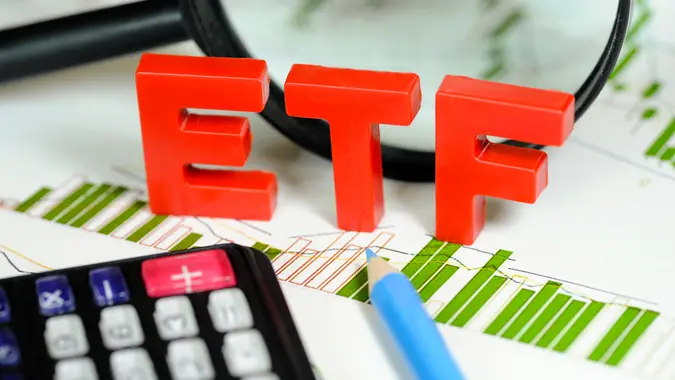Best Ways To Invest $10K in 2025

Commitment to Our Readers
GOBankingRates' editorial team is committed to bringing you unbiased reviews and information. We use data-driven methodologies to evaluate financial products and services - our reviews and ratings are not influenced by advertisers. You can read more about our editorial guidelines and our products and services review methodology.

20 Years
Helping You Live Richer

Reviewed
by Experts

Trusted by
Millions of Readers
Have $10,000 to invest? Whether it came from savings or a bonus, putting it to work can grow your wealth. Here are smart ways to invest $10K based on your risk tolerance and goals.
See: The Top 4 Ways Wealthy People Make Money Without Doing Anything
How Can I Invest $10,000?
When deciding how to invest $10,000, consider your personal finance and retirement goals — the best investments are the ones that can help you meet them. You could play it safe and park the cash in a high-yield savings account, where it could earn a few hundred dollars in a year as long as interest rates stay up. But other investments could boost your returns. Here are some top options:
401(k) or IRA
- Best for: Retirement
- Potential returns: 5%-10%
- Risk level: Low-moderate
- Why it works: Tax-advantaged savings help build compound interest faster.
For 2025, you can contribute up to $23,500 to a 401(k). If you’re 50 or older, you can avail of a catch-up contribution of up to $7,500, or as much as $11,500 if you are between 60 and 63. If you’re looking for a great way to invest your $10,000, consider increasing your 401(k) contributions.
Another option is to contribute to an individual retirement account. An IRA is a tax-advantaged savings account similar to a 401(k). You can also contribute to an IRA even if you have a 401(k) or pension available through your employer. Contributions to a traditional IRA are tax-deductible, and you pay taxes on the withdrawals you make after you’ve retired. A Roth IRA lets you contribute taxed funds now so the withdrawals in retirement are tax-free.
If you need the deduction to lower your taxable income now and expect to be in a lower tax bracket after you retire, a traditional IRA may be a good place to invest some of your extra $10,000. If you’d rather not worry about paying taxes on the withdrawals in the future, a Roth IRA may be a better idea.
Contribution limits for both types of IRAs are $7,000 per year, plus an additional $1,000 if you’re 50 or older. Note that these contribution limits apply to all IRAs — whether Roth or traditional — combined. So if you have a traditional IRA and a Roth IRA, you can’t contribute more than the limit to either or both. The 401(k) is a different animal, however, with its own contribution limits.
Health Savings Account (HSA)
- Best for: Medical savings
- Potential returns: 3%-5%
- Risk level: Low
- Why it works: Triple tax advantages — on contributions, earnings, and qualified withdrawals — make this a top way to pay for health care.
A health savings account lets you save pretax money for medical expenses if you have a high-deductible health insurance plan. You can contribute up to $4,300 if you’re the only one on your insurance plan or $8,550 if you have a family plan. After you turn 55, you can contribute an additional $1,000 per year.
The money you put into an HSA grows tax-deferred, and the money you take out is tax-free if you withdraw it to pay eligible healthcare expenses. And you can roll it over from one year to the next — all the way up to and into retirement. When you consider that the average 65-year-old should have around $165,000 set aside to cover healthcare expenses in retirement, according to Fidelity, an HSA can be a smart investment.
Real Estate / REITs
- Best for: Passive income
- Potential returns: 6%-10%
- Risk level: Moderate
- Why it works: REITs offer a diversified, managed way to own real estate and generate consistent income.
Although you likely will not be able to buy a house or building with $10,000, you can still invest your cash in real estate. One option is to buy vacant land that you could later build on or sell for a profit. It’s a low-maintenance investment, but one that can be hard to convert to cash when you need it.
Of course, you can invest in real estate without putting your name on a deed. Real estate investment trusts give you access to commercial real estate investing. A REIT is actually a company that owns office buildings, apartments and other types of property, and you can buy or sell shares of the company like stock. REITs tend to pay dividends that can produce an income stream.
Index Funds
- Best for: Long-term growth
- Potential returns: 6%-8%
- Risk level: Moderate
- Why it works: Index funds allow investors to passively replicate the returns of an index, such as the S&P 500, for a very low cost. Fund holdings are transparent and changed infrequently.
An index fund is a collection of stocks that seeks to replicate an index or an investment benchmark. You can buy an index fund that includes the stocks in the Dow Jones Industrial Average, for example, or the S&P 500.
Index funds are passively managed, which means that investments in the fund are bought and sold only to remain true to the index. An index fund is designed to provide the same return as the index it follows, so it won’t outperform the benchmark.
Many index funds are exchange-traded. Exchange-traded funds, or ETFs, are funds that trade like stocks. This means that their prices change throughout the day, and they typically have very low fees.
Mutual Funds
- Best for: Diversification
- Potential returns: 5%-8%-plus
- Risk level: Moderate
- Why it works: Mutual funds provide instant diversification in a single purchase, along with active management by professionals on your behalf.
A mutual fund is a “basket” of stocks, and investors purchase shares of the fund. Because there are different stocks in the basket, a mutual fund provides more diversification than an individual stock. Mutual funds are actively managed, meaning that there is a portfolio manager who watches the fund, buying and selling positions as they see fit.
Individual Stocks
- Best for: High return potential
- Potential returns: Varies; more than 10% possible
- Risk level: High
- Why it works: With careful research and risk management, picking individual stocks can generate market-beating returns; however, there is higher risk involved.
Picking your own stocks entails more risk than buying index or mutual funds, but there is also the potential for a greater return. For a new investor, the best advice may come from legendary investor Warren Buffett: Buy what you know. Consider the stocks of companies that make the products you use and, ideally, can’t live without. If it’s a newer product that’s just beginning to take off, so much the better.
If you’re going to invest in individual stocks, you can manage the portfolio yourself with an app like Robinhood or E*TRADE, use a discount broker like Fidelity, or get some help from a full-service broker like Charles Schwab or Edward Jones. Some firms offer both discount and full-service options.
Keep in mind that you get what you pay for — a full-service broker will cost you more in commissions and fees. In exchange for that cost, you get advice on what to buy, sell and hold.
Low-Risk Fixed Income Strategies
If you’re looking to preserve your capital more than to grow it, consider these low-risk fixed-income strategies that can provide you with a return without putting your principal in jeopardy.
Series I Bonds
- Best for: Keeping up with inflation
- Potential returns: Variable; currently
- Risk level: Low
- Why it works: Series I bonds adjust their pay rate based on the current inflation rate, helping to preserve the purchasing power of your money.
Savings bonds may seem like a boring, old-fashioned investment, but they can be useful in volatile markets. And I bonds are not your grandfather’s savings bond. They provide a hedge from inflation because the interest rate is tied to inflation.
Here’s how they work. You can buy up to $10,000 worth of I bonds in a calendar year. The bonds pay interest for 30 years. The interest is based on two rates: a fixed rate for the life of the bond, plus a rate that changes every six months with inflation. The fixed rate and the inflation rate are announced every May 1 and Nov. 1. I bonds purchased between November 1, 2024 and April 30, 2025 are currently paying a 3.11% rate of interest, according to TreasuryDirect.
Interest on I bonds is compounded semiannually. When you cash in your I bond, you get the principal plus all the interest earned for as long as you’ve had the bond. You must wait at least one year after buying an I bond to cash it in, and if you cash it in before five years have elapsed, you’ll pay a penalty of three months’ interest.
To purchase Series I savings bonds, go to the TreasuryDirect website.
CD Ladder
- Best for: Protection against shifts in interest rates
- Potential returns: 3%-5%
- Risk level: Low
- Why it works: If interest rates rise, maturing money is reinvested at higher rates; if interest rates fall, a portion of the CD ladder is locked in at higher rates.
Like all fixed interest rates, certificate of deposit rates are going up. But rates can — and probably will — fall again, and CDs lock in your money for a fixed period of time. The longer the term, the more risk that rates will rise and you’ll earn less than you otherwise could.
The answer to this dilemma is a CD ladder. To create a CD ladder, you purchase CDs with varying maturities.
For example, with your $10,000, you could open four $2,500 CDs, one for each of the following terms: one year, two years, three years and five years. When your one-year CD matures, you can put that money into a longer-term CD if you think interest rates will continue to rise, because you’ll have another CD coming due in another year. When that one matures, you can make the decision about whether to put that money away for the short term or the long term. Because you have some of your money maturing every year or two, you minimize your interest rate risk.
Treasury Securities
- Best for: Income and principal backed by the U.S government; state tax benefits
- Potential returns: 3%-5%
- Risk level: Low
- Why it works: Treasuries are backed by the full faith and credit of the United States Government, making them among the safest investments in the world. Income generated by Treasuries is exempt from state taxation.
Treasury securities are debt instruments issued by the U.S. government. If you buy a U.S. Treasury, you are essentially lending the government money in exchange for the promise of interest payments and the return of your principal at maturity.
Treasury securities come in three forms: bills, notes, and bonds. Treasury bills have maturities from 4 weeks to 52 weeks. Notes have maturities of up to 10 years, while Treasury bonds mature in either 20 or 30 years. Each carries its own risk/reward profile. However, if you hold your Treasuries to maturity, you don’t have to worry about fluctuations in value or in receiving your principal amount back.
How Major Investment Options Compare
Here’s a quick side-by-side comparison of the characteristics of top investment classes.
| Investment Type | Best For | Estimated Return | Risk Level |
| 401(k)/IRA | Retirement | 7% avg | Low to Moderate |
| HSA | Medical savings | 3-5% | Low |
| REITs | Passive income | 6-10% | Moderate |
| Index Funds | Long-term growth | 6-8% | Moderate |
| CDs | Safe returns | 3-5% | Low |
| Individual Stocks | High return potential | Varies | High |
Which Investment Strategy Is Right for You?
If you’ve fully funded your emergency fund, you’re ready to deal with surprise expenses. Once you’ve done that, it’s time to put your money to work. Whatever you decide to do with your $10,000 in savings, it should be something you are comfortable with and something that furthers your financial goals.
- Want long-term retirement savings? Try a 401(k), IRA, or HSA.
- Want flexibility and growth? Consider index funds or ETFs.
- Prefer guaranteed returns? Look at I Bonds or a CD ladder.
Allison Hache contributed to the reporting for this article.
Our in-house research team and on-site financial experts work together to create content that’s accurate, impartial, and up to date. We fact-check every single statistic, quote and fact using trusted primary resources to make sure the information we provide is correct. You can learn more about GOBankingRates’ processes and standards in our editorial policy.
- IRS. 2022. "401(k) limit increases to $22,500 for 2023, IRA limit rises to $6,500."
- IRS. 2023. "Retirement Topics - IRA Contribution Limits."
- IRS. 2023. "Internal Revenue Bulletin: 2023-22."
- Investor.gov. "Real Estate Investment Trusts (REITs)."
- Fidelity. "How to plan for rising health care costs."
 Written by
Written by  Edited by
Edited by 

























